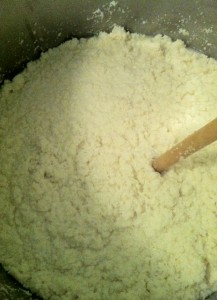“Perhaps a hundred.”
That is the simplest answer to the question, “how many types of sake rice are there?” At any one given time, there are about a hundred.
 Why the vague answer? First of all, because we are dealing with sake. It’s just the way it is. But also, I say “perhaps a hundred” because at any one time, there are about a hundred being grown across Japan. Each year, few more sake rice types are created through crossbreeding or spontaneous change, and a few are abandoned by the growing and brewing communities. So, it might be 90, it might be 110, but about a hundred are used each year.
Why the vague answer? First of all, because we are dealing with sake. It’s just the way it is. But also, I say “perhaps a hundred” because at any one time, there are about a hundred being grown across Japan. Each year, few more sake rice types are created through crossbreeding or spontaneous change, and a few are abandoned by the growing and brewing communities. So, it might be 90, it might be 110, but about a hundred are used each year.
Of those one hundred or so, kind of like grapes used in winemaking, if you know of the top dozen or so, you’re fine. Those dozen will make up the lion’s share of the rice used. The usual suspects: Yamada Nishiki, Omachi, Gohyakumangoku, Miyama Nishiki, Hattan Nishiki – these are the most visible and oft-encountered varieties.
A natural progression along the lines of this topic will eventually meander to, “Do they ever blend these rice varieties?” And the short answer is, “no.”
 Basically, a sake will most often be made with one rice and one rice only. Are there exeptions? Of course there are. There are always exceptions in the sake world. But most of the sake out there is made with one and only one rice.
Basically, a sake will most often be made with one rice and one rice only. Are there exeptions? Of course there are. There are always exceptions in the sake world. But most of the sake out there is made with one and only one rice.
Why? Why not blend? The biggest reason is that different rice types behave differently. The way they behave when being milled, being soaked and steamed, having mold grown upon them, and most importantly the way they dissolved in the moromi (fermentation mash) are different. And if brewers want one thing during sake making, it is some semblance of predictability, a way to know that things are proceeding in the way they hope.
Living things like moromi (fermenting mash) do not always behave like we expect, so the way to counter that is to remove what variables you can. And if you have two different rice types going about their own business with their own idiosyncrasies in the same tank, it is much harder to deal with the other countless variables, and create the sake with an aimed-for level of consistency.
There are other reasons as well, but in the end, more than one rice is not usually used in a given tank. But as stated above, there are exceptions. What of those exceptions? Why and how? In short, very often a better rice is used for the koji, and a lesser rice is used for the kakemai. In other words…
Many readers surely recall that about 25% of all the rice going into a
given batch of sake has a mold (aspergillus oryzae) grown onto it. The resultant moldy rice is called koji, and from it come the enzymes that chop the starch in all the rice into sugar, which can then be fermented by the yeast. The remaining 75% of the rice added to the batch contributes more starch albeit no more enzymes, and is known as kakemai. And it is the koji, and by extension the rice used to make it, that holds much more leverage over the nature of the final sake.
So back to our blending topic, in the rare occasions that we do see more than one rice used in a single batch, the most common example is that a better rice is used for the koji (the more important moldy stuff), and a lesser for the kakemai (the still-important-but- less-so starch-contributing stuff).
Stated conversely and perhaps a bit less appealingly, one way to lower the cost of a sake is to use a lesser rice for the kakemai. And this is when we might see blending.
Note that rice is almost never blended for flavor-related reasons, like grapes might be. Sure, while different rice types do have differing flavor profiles, the rice-to-sake flavor connection is not as tight as the grapes-to-wine flavor connection. So the practice of blending would not yield such pronounced or predictable results. But note, to this principle too, there are some exceptions.
Also, as a quick yet deceivingly important point: note that sake brewers are not obligated to list the name of the rice used on the label. Many do, especially for premium sake, but there is no obligation to do so. But if they do in fact choose to list the name of the rice, they are then obligated to say what percent of the total amount of rice used corresponds to the listed rice. “Yamada Nishiki 100 percent,” for example. Or “Yamada Nishiki 25 percent, Kita Nishiki 75 percent,” might be another commonly seen example.
Finally, this might change. I have heard from more than one brewer that – especially for small, boutique brewers, blends of individual tanks that yield the most enjoyable, unique and premium sake – may be the way of the future. There is nothing preventing this, and I personally think it would be a welcomed move that would improve sake’s appeal and specialness.
Still, at least for now, blending rice types and blending discrete tanks for one-of-a-kind flavor reasons is not at all a common practice in sake brewing. Just beware the exceptions.






